Click below to jump to an article of interest.
Expanded Valve Testing, Research
SwRI has expanded its flow component testing facilities and capabilities to evaluate the performance and safety of valves, particularly those used in emerging carbon capture and hydrogen transport applications.
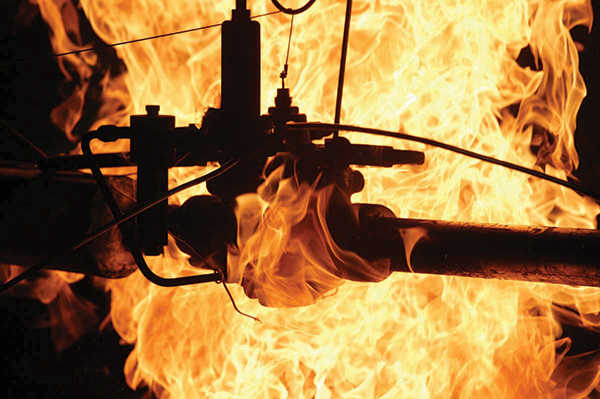
In addition to fire testing valves, SwRI offers a range of hydrogen safety evaluations and research, including evaluating valves for material compatibility and performance.
Nitrogen Blowdown
SwRI’s Blowdown Facility recreates the intense conditions of gas events, making it possible to test subsurface safety valve (SSSV) performance at high pressures to prevent injury, loss of life and environmental effects.
The facility recently recorded its highest-ever nitrogen flow rate of 310 million standard cubic feet per day (MMscfd) at 2,400 pounds per square inch gauge (psig). In addition to allowing more strenuous testing for SSSVs and other safety and pollution prevention equipment, SwRI is expanding its valve testing capabilities to evaluate existing SSSVs for carbon capture and storage (CCS) applications to support clean energy initiatives. Companies can reduce their carbon footprint by capturing and sequestering carbon dioxide (CO2) in subsurface caverns, reservoirs or depleted oil wells. SSSVs can safeguard these storage applications.
“CO2 storage is challenging, because the fluid can be very cold and solidify under certain conditions,” said Nicole Lemon, a research engineer in SwRI’s Fluids Engineering Department. “Increased safety measures are needed for CCS testing because CO2 properties can change dramatically based on temperature and increased pressure. Increased safety measures are required for any testing program with CO2 to avoid a gas event.”
Investigating how existing SSSV designs perform at cold temperatures in CCS applications is critical prior to long-term service. SwRI’s experience with cryogenic and extreme cold testing can help the energy industry evaluate existing SSSV designs and test newly developed hardware.
Hydrogen
In seeking to decrease greenhouse gas emissions, the oil and gas industry is looking at blending hydrogen into natural gas streams that will ultimately be used for power generation or residential heating. This would require valve infrastructure to be less susceptible to hydrogen-related embrittlement and more leak-tight.
“Transitioning to hydrogen gas that works with existing infrastructure could offer a more natural progression away from carbon-based fuels,” said SwRI’s Angel Wileman, who heads the Institute’s Thermofluids Section in the Mechanical Engineering Division. “Finding clean energy solutions using hydrogen comes with its own unique set of challenges, however. Challenges that SwRI can help evaluate and overcome.” (See “Hydrogen and a Carbon-Neutral Future” feature story)
Hydrogen-specific valves must operate at either very low temperatures or high pressures to safely store hydrogen. SwRI offers nearly all testing methods for hydrogen valves, including fire testing and the international standard, ISO 19880-3. Test pressures can reach over 15,000 psig.
SwRI test facilities are accredited through the American Petroleum Institute (API) to perform validation testing on both surface and subsurface safety valves. The facilities accommodate safety testing of other flow components such as oilfield tools, pumping units and even fire hydrants. All testing is completed under an API Q1 and ISO 17025 quality management system.
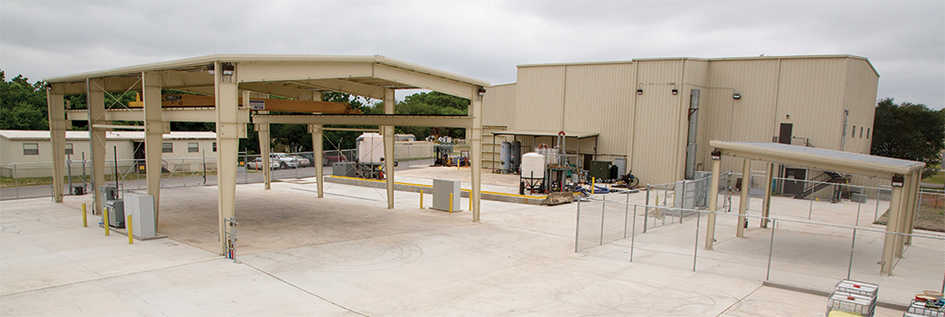
SwRI’s Flow Component Testing Facilities perform both standard and custom testing, including CO2 SSSV testing.
Vehicle Cybersecurity, Intrusion Detection
SwRI engineers have developed an intrusion detection system (IDS) to protect military ground vehicles against cyberthreats to embedded systems and connected vehicle networks.
Developed in collaboration with the U.S. Army Ground Vehicle Systems Center (GVSC) Ground System Cyber Engineering (GSCE) Directorate, the IDS technology uses digital fingerprinting and algorithms to identify communications anomalies across automotive systems and components.
Military, passenger and commercial vehicles use the standard Controller Area Network (CAN) bus protocol to enable communications across various microprocessor nodes or electronic control units. The CAN protocol, for example, informs a dashboard display when a sensor detects low oil pressure or when headlights are turned on. It also relays operational communications for systems such as transmissions and other critical automotive technology.
“A cyberattack could potentially send erroneous information across the CAN protocol to alter or impede a vehicle’s operations,” said SwRI’s Jonathan Wolford, who co-authored a paper on the subject. “An attack on several connected vehicles could have disastrous effects.”
Since 1986, CAN has been a standard automotive protocol, providing a reliable and flexible platform to transmit information. However, it was not designed with cybersecurity protections in mind. As modern vehicles become increasingly connected via external networks, the CAN system is more vulnerable to potential cyberattacks from bad actors sending false messages.
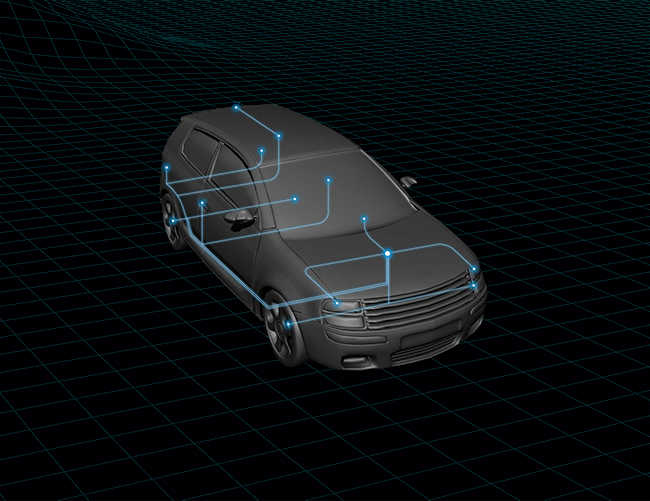
SwRI’s new algorithms digitally fingerprint messages on nodes that transmit information via the CAN bus protocol. Digital fingerprinting allows SwRI’s intrusion detection systems to identify when an unknown/invalid node or computer is connected to the vehicle network. These algorithms use the CAN transceiver’s message transmission to track low-level physical layer characteristics — such as the minimum and maximum voltages as well as the voltage transition rates for each CAN frame — to create these digital fingerprints.
The researchers trained the system with baseline data to build a fingerprint of each node, understand characteristics and better identify anomalies. With digital fingerprinting, the intrusion system accurately identifies messages sent from unauthorized nodes or when a valid node is sending spurious messages indicative of a “masquerade attack.”
After training the system, SwRI engineers injected false data, and the algorithms flagged them instantly. The system is capable of both identifying threats and defending against them.
“These attacks are theoretically easier for bad actors who have physical access to a vehicle, but vehicles are also vulnerable to wireless attacks,” said SwRI’s Peter Moldenhauer, who co-authored the research paper. “Our system is designed to build cyber resiliency into the CAN protocol as we move to more connected and automated vehicle networks.”
While developed for military vehicles, the system can also be used to identify anomalies in passenger cars and commercial vehicles.
The research team won the Best Paper Award for the Cyber Technical Session at the 2022 Ground Vehicle Systems Engineering & Technology Symposium (GVSETS) conference. The paper is titled “Cyberattack Defense through Digital Fingerprinting, Detection Algorithms, and Bus Segmentation in Ground Vehicles.”
Pluto's Atmosphere Decreasing, Freezing onto its Surface
When Pluto passed in front of a star on the night of August 15, 2018, an SwRI-led team of astronomers was watching. Numerous telescopes deployed at sites across the U.S. and Mexico observed Pluto’s atmosphere as it was briefly backlit by the well-placed star. Scientists used this occultation event to measure the overall abundance of Pluto’s tenuous atmosphere. The team found compelling evidence that Pluto’s atmosphere is beginning to disappear, refreezing back onto its surface as it moves farther away from the Sun.

Courtesy of NASA/JHU APL/SwRI
When Pluto passed in front of a star, an SwRI-led team of astronomers measured the abundance of Pluto’s atmosphere, shown here in New Horizons 2015 flyby data, and determined that it is dwindling.
The occultation took about two minutes, during which time the star faded from view as Pluto’s atmosphere and solid body passed in front of it. The rate at which the star disappeared and reappeared determined the density profile of Pluto’s atmosphere.
“Scientists have used occultations to monitor changes in Pluto’s atmosphere since 1988,” said Dr. Eliot Young, a senior program manager in SwRI’s Space Science and Engineering Division. “The New Horizons mission obtained an excellent density profile from its 2015 flyby, consistent with Pluto’s bulk atmosphere doubling every decade, but our 2018 observations do not show that trend continuing from 2015.”
Like Earth, Pluto’s atmosphere is predominantly nitrogen. Unlike Earth, Pluto’s atmosphere is supported by the vapor pressure of its surface ices, which means that small changes in surface ice temperatures would result in large changes in the bulk density of its atmosphere.
Pluto takes 248 Earth years to complete one full orbit around the Sun, and its distance varies from its closest point, about 30 astronomical units from the Sun (1 AU is the distance from the Earth to the Sun), to 50 AU from the Sun. For the past quarter century, Pluto has been receiving less and less sunlight as it moves farther away from the Sun, but until 2018 its surface pressure and atmospheric density continued to increase. Scientists attributed this to a phenomenon known as thermal inertia.
“An analogy to this is the way the Sun heats up sand on a beach,” said SwRI Staff Scientist Dr. Leslie Young, who specializes in modeling the interaction between the surfaces and atmospheres of icy bodies in the outer solar system. “Sunlight is most intense at high noon, but the sand then continues soaking up heat over the course of the afternoon, so it is hottest in late afternoon. The continued persistence of Pluto’s atmosphere suggests that nitrogen ice reservoirs on Pluto’s surface were kept warm by stored heat under the surface. The new data suggest they are starting to cool.”
The largest known nitrogen reservoir is Sputnik Planitia, a bright glacier that makes up the western lobe of the heart-shaped Tombaugh Regio. The 2018 data will help atmospheric modelers improve their understanding of Pluto’s subsurface layers, particularly regarding compositions that are compatible with the observed limits on heat transfer.
SwRI Studies Hypersonic Separation Systems
SwRI is collaborating with The University of Texas at San Antonio to advance hypersonics research under a three-year, $1.5 million grant through the University Consortium for Applied Hypersonics. As a subcontractor to UTSA, SwRI will design experiments to push the envelope on hypersonic system designs and provide methods to better model complex system behavior.
Hypersonic speeds are faster than five times the speed of sound, or greater than Mach 5. When something is flying that fast, the air around the flying object becomes superheated by shockwaves. Depending upon the speed, some points behind the shockwave are hotter than the surface of the Sun, causing the air to chemically decompose. This strange chemical environment can cause these flight bodies to heat up, melt and chemically react with the air, which poses a unique challenge for aerospace applications that require a separation event to occur.
Separation events happen when two or more parts of a vehicle intentionally come apart. SwRI’s Dr. Nicholas Mueschke, program manager of SwRI’s Computational Mechanics Section, is leading hypersonic separation experiments that aim to better understand the driving factors that must be considered to achieve successful separation.
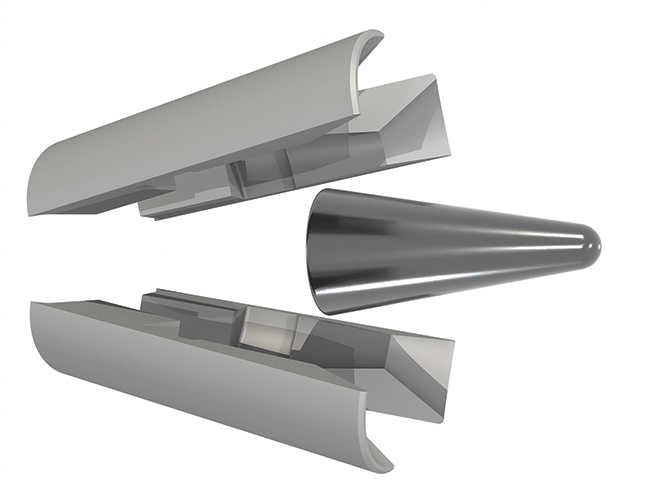
This image of hypersonic separation illustrates a conical flight body separating from a sabot after leaving the launch tube of the light-gas gun. Sabots encase projectiles to keep them aligned in the center of the barrel when fired.
Separation events are commonplace in many aerospace applications. For example, rocket boosters are ejected during space launches, including some that now return to the launch pad after separation. Military aircraft require safe separation of payloads carried underwing or within storage bays. Some rocket nose cones are designed to protect launch packages, such as satellites, which split open and separate from the vehicle in flight.
“Flying at hypersonic speeds within the atmosphere makes the aerodynamics and loads experienced by separating structures more difficult to predict and harder to safely design around, because the time-scales of these events are squeezed into milliseconds,” Mueschke said.
As next-generation hypersonic technology progresses, the ability to support separating components must also advance. A booster that separates from a vehicle, for example, allows for extended range and novel flight corridors. The challenge is designing components that can separate easily to avoid damaging or upsetting the primary vehicle, while withstanding the extreme aerodynamics and thermal environment associated with traveling at hypersonic speeds.
SwRI is designing novel experiments to evaluate hypersonic system designs while also providing methods to better model complex system behavior during separation events. The team is using the Institute’s two-stage light-gas gun and ballistic testing facilities to simulate hypersonic flight conditions, which allows researchers to image objects in hypersonic flight.
“The goal is to generate aerodynamic and kinematic data that will anchor high-fidelity simulation models,” Mueschke said. “We will also leverage some of our advanced simulation capabilities to design these experiments and evaluate how simulation models can improve future vehicle designs.”
Ultimately, said Mueschke, this work is part of the broader effort to leverage hypersonic technology to deliver operational capability and options to combatant commanders that otherwise do not exist today.
The University Consortium for Applied Hypersonics is an inclusive, collaborative network of universities working with government, industry, national laboratories, federally funded research centers and existing university-affiliated research centers. It aims to deliver the innovation and workforce needed to advance modern hypersonic flight systems in support of national defense.
NASA's New Horizons Probe Measures UV Brightness of the Milky Way
A new study has determined the brightness of the galactic Lyman-alpha background light using an SwRI-developed instrument aboard NASA’s Kuiper Belt space probe New Horizons.
The Lyman-alpha ultraviolet background, first detected in space in the 1960s and confirmed in 1971, bathes space in an ultraviolet glow. In most of our solar system, the background is dominated by Lyman-alpha photons emitted by the Sun and scattered by interstellar hydrogen atoms passing through. In the outer solar system, however, the scattered sunlight component of the Lyman-alpha signal wanes, making it easier to distinguish fainter components from the Milky Way.
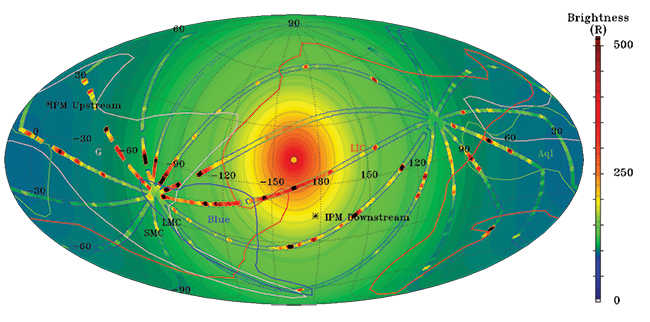
Courtesy of NASA/JHU APL/SwRI
From its vantage point aboard the New Horizons spacecraft traveling near the edge of the solar system, the SwRI-led Alice UV spectrograph characterized the subtle galactic component of the Lyman-alpha background UV glow. This false-color map illustrates the Sun-dominated Lyman-alpha component in orange as it fades to reveal the faint background UV light emitted by the Milky Way.
“The galactic Lyman-alpha background comes from hot regions around massive stars that ionize all nearby matter, primarily hydrogen, the most abundant element in the universe,” said SwRI’s Dr. Randy Gladstone, the study’s lead author. “When the electrons and protons eventually get back together, or recombine, they nearly always emit Lyman-alpha photons.”
Hydrogen atoms between the stars scatter these photons into a roughly uniform glow throughout space. They are detectable, but only at the Lyman-alpha wavelength, which is not visible to human eyes. Because the solar component is so bright near the Earth, scientists could not tell how much light from the Milky Way galaxy contributed to its overall brightness.
“It’s like standing near a streetlamp on a foggy night,” Gladstone said. “The fog scatters the lamp’s light, making it hard to see anything else. New Horizons has been flying away from the Sun for more than 15 years now. The farther we moved away from the Sun, the less we were blinded by the solar component of the Lyman-alpha background.”
With the SwRI-led Alice UV imaging spectrograph aboard New Horizons, Gladstone was able to accurately measure the brightness of the galactic component of the Lyman-alpha background for the first time. New Horizons is now far beyond Pluto, allowing Gladstone to determine that the glow is 20 times dimmer than the Lyman-alpha background is near Earth.
This has been something that’s been guessed at by astronomers for decades,” Gladstone said. “Now we have a much more precise number.”
Gladstone hopes that this discovery will help astronomers better understand the nearby regions of the Milky Way galaxy.
“The unique position of New Horizons in the faraway Kuiper Belt allows it to make discoveries like this that no other spacecraft can,” said SwRI Associate Vice President Dr. Alan Stern, New Horizons principal investigator. “What a great resource New Horizons is, not just for the exploration of the Kuiper Belt, but also to understand more about our galaxy and even the universe beyond our galaxy through this and other observations by our scientific instrument payload.”
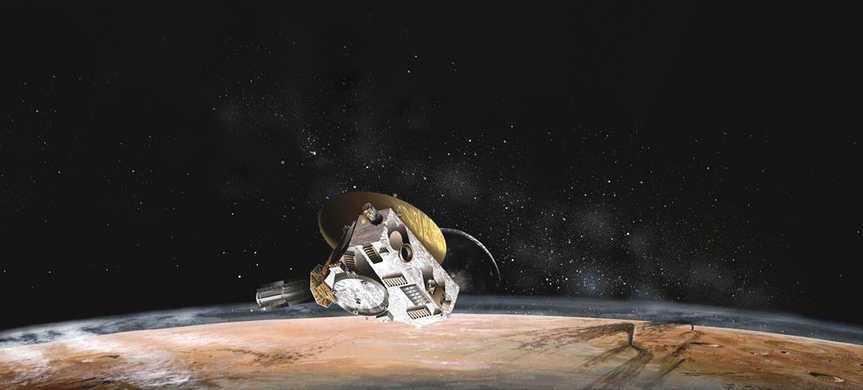
Courtesy of NASA/JHU APL/SwRI
Characterizing Offshore Oil Fields
SwRI geologists completed research characterizing the complex geological evolution of the Orphan Basin, located off the eastern coast of Newfoundland and Labrador. Using an extensive database of new 2D and 3D broadband seismic reflection data, geologists were able to visualize and understand the area’s subsurface.
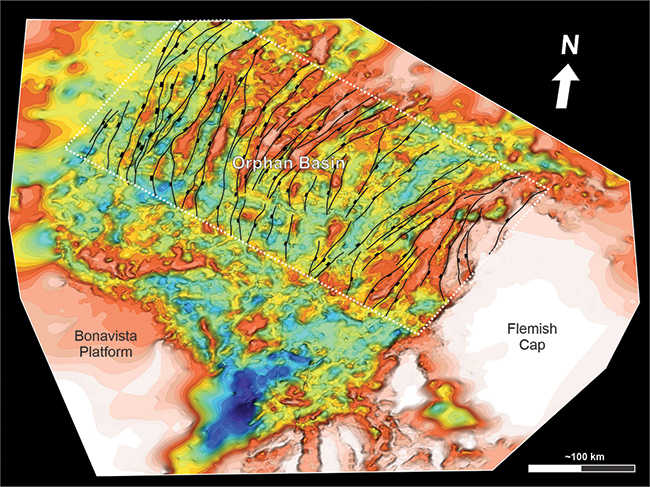
“By incorporating seismic interpretations of rock structures and layers, along with regional gravity and magnetic data and estimates of crustal thicknesses, we were able to generate structural interpretations of the Earth’s crust,” said SwRI’s Dr. Adam Cawood, who led the research and is lead author of two recent papers on the subject. “Integrating multiple datasets is critical for understanding complex structural development in frontier oil and gas exploration regions.”
The Orphan Basin and Flemish Pass region on the Newfoundland continental margin is a frontier area for oil and gas exploration. The region has historically been poorly understood in terms of structural and tectonic evolution, with few exploration wells and, until recently, sparse seismic data coverage.
“We characterized the region using 2D and 3D seismic data, interpreting structural geometries and basin evolution through time,” said SwRI’s Dr. David Ferrill, who co-authored the papers. “These analyses provide the context for upcoming assessments of location and distribution of source rock, reservoir and seal strata for exploration in the area.”
The team used defined protocols for cross-section construction and restoration, testing multiple scenarios and generating robust models for the geologic evolution of the Orphan Basin, Flemish Pass and Flemish Cap region.
“By doing this, we can better understand the tectonic evolution and related sediment accumulation during the formation of the North Atlantic, when the supercontinent of Pangea broke up and land masses drifted apart,” Cawood said. “These results are important for interpreting the oil and gas potential in this frontier area.”
Cleaner Diesel Fuels
SwRI worked with a client to develop a post-refinery fuel treatment process that reduces exhaust emissions from diesel engines. The result is a modified fuel that could potentially replace today’s ultra-low sulfur diesel, biodiesel and other renewable diesel fuels.
When burning a fuel-air mixture, internal combustion engines produce harmful pollutants such as soot and nitrogen oxides (NOx). Engineers design and calibrate engines to decrease emissions but have been stymied by the soot/NOx trade-off. Attempts to reduce soot with increased temperatures result in higher NOx, while lowering the temperature has the opposite effect. The modified fuel produces less soot emissions without increasing NOx and without requiring engine design or calibration changes.
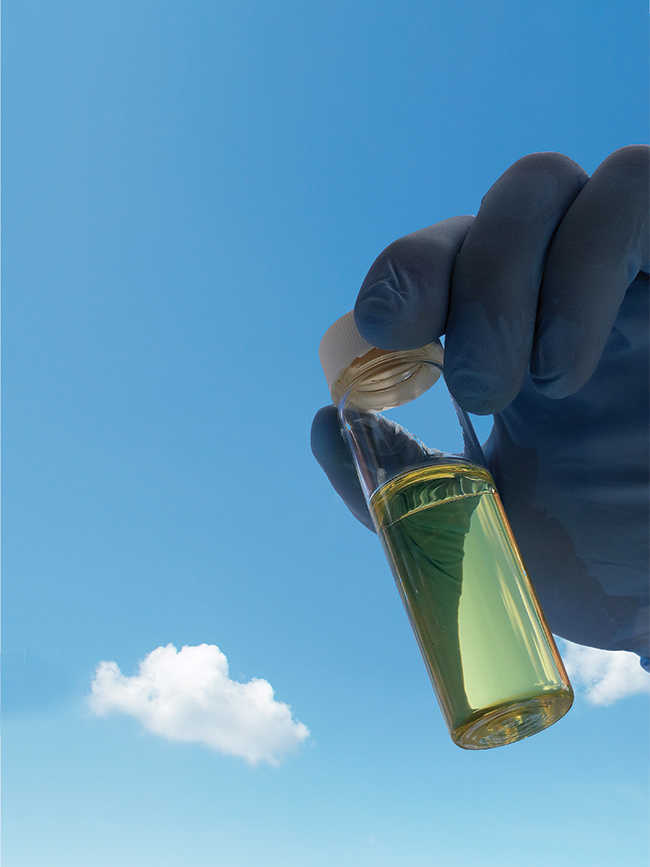
Although engine manufacturers routinely develop cleaner engines for new vehicles, older model vehicles continue to contribute heavily to pollution levels. This new modified fuel could potentially lower exhaust NOx and particulates for both older and newer model diesel engine vehicles.
“While fossil fuels eventually may be replaced by electric powertrains or noncarbon fuels in our lifetime, the process developed with our client could be implemented immediately,” said James Wood, a principal scientist in SwRI’s Chemistry and Chemical Engineering Division. “Reducing soot and NOx could potentially protect human health and the environment from harmful emissions.”
SwRI designed, built and operated a bench-scale processing plant to produce modified fuel samples for laboratory testing. This internationally patented breakthrough technology combines a unique low-concentration chemical treatment with a specialized mechanical mixing system to produce a stable diesel fuel.
SwRI’s Powertrain Engineering Division evaluated the fuels during steady-state and transient engine emissions testing according to Environmental Protection Agency test procedures.
“The modified fuel resulted in a substantial reduction in soot mass emissions compared to the baseline ultra-low sulfur diesel,” said Dr. Imad Khalek, a senior program manager who operates SwRI’s particulate laboratory.
Based on the bench-scale plant, SwRI helped design a production-scale facility that meets ASTM International and ANSI (American National Standards Institute) standards and is capable of processing 12,000 barrels per day (150 million gallons per year). Production of the modified fuel is ready for commercial development.
NASA Selects SwRI-Led CubeSat Mission
NASA has selected the SwRI-led CubeSat Imaging X-Ray Solar Spectrometer (CubIXSS) as a secondary payload on an upcoming satellite launch. The nanosatellite will measure the composition of multimillion-degree plasmas in the solar corona — its outermost atmosphere — to characterize the origins of hot ionized gases in active regions of the Sun.
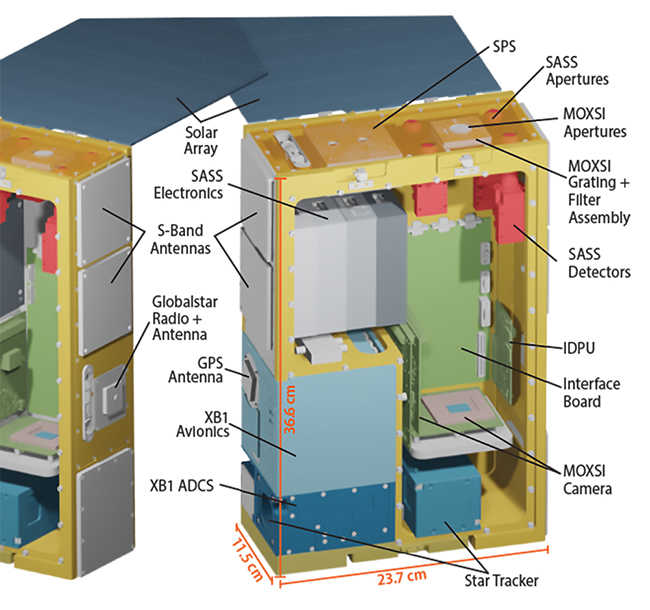
NASA has selected the SwRI-designed CubIXSS as a secondary payload for an upcoming satellite launch. The shoebox-sized CubeSat includes multiple spectrometers to quantify elements in the Sun’s corona and tease out the origin of hot plasmas in active regions that spawn explosive events such as solar flares.
The Sun’s active regions are characterized by disturbances in its magnetic fields. These regions spawn explosive solar events such as solar flares and coronal mass ejections (CMEs).
“As a magnetic field in an active region becomes increasingly twisted and tangled, it basically ‘snaps’ back into a less tangled shape,” said SwRI Principal Scientist Dr. Amir Caspi, the mission’s leader. “That snap releases a lot of energy and creates events such as solar flares.”
The solar flare heats the Sun’s plasma in that region to tens of millions of degrees Celsius, considerably hotter than the rest of the solar corona.
“We don’t know how much plasma in solar flares is heated directly in the corona and how much is heated in the Sun’s lower atmosphere and then transported up to the corona,” Caspi said. “CubIXSS will measure X-rays from these phenomena to help us unravel this mystery.”
CubIXSS is a larger CubeSat, about the size of a shoebox. It will carry multiple spectrometers to measure different wavelengths or “colors” of solar X-rays, including a new instrument that will quantify certain ions that only exist in a specific range of temperatures. Measuring the abundance of these elements at each temperature will provide insight into where heated plasmas originate.
“Studying the Sun is very important for people living on Earth,” Caspi said. “CMEs and solar flares can disrupt satellite and ground-based communications. Understanding how these things happen will help us understand why they happen, which will help us predict these events and mitigate their effects.”
Inspecting Aircraft Engine Materials
The dark regions in this image show the “dirty white spots” sometimes found in nickel alloy engine components, anomalies that can lead to catastrophic failures. Under a new FAA contract, SwRI will develop new inspection methods to ensure anomalies like these are detected during the material manufacturing process.
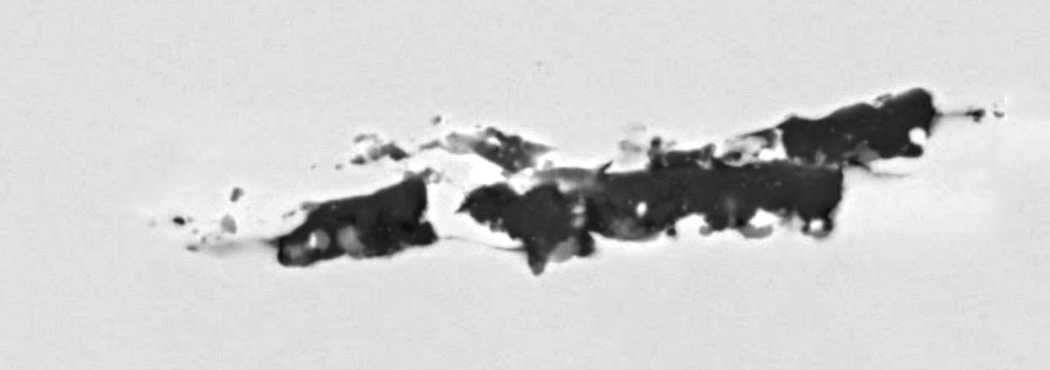
Courtesy of FAA
West Texas Spring Study
SwRI hydrologists are conducting a two-year investigation of West Texas spring systems to improve water resource management for semiarid regions. Funded by a WaterSMART Applied Science Grant from the U.S. Bureau of Reclamation, the project is studying vital water systems at potential risk, including San Solomon Springs.

SwRI Demonstrates Drone Autonomy
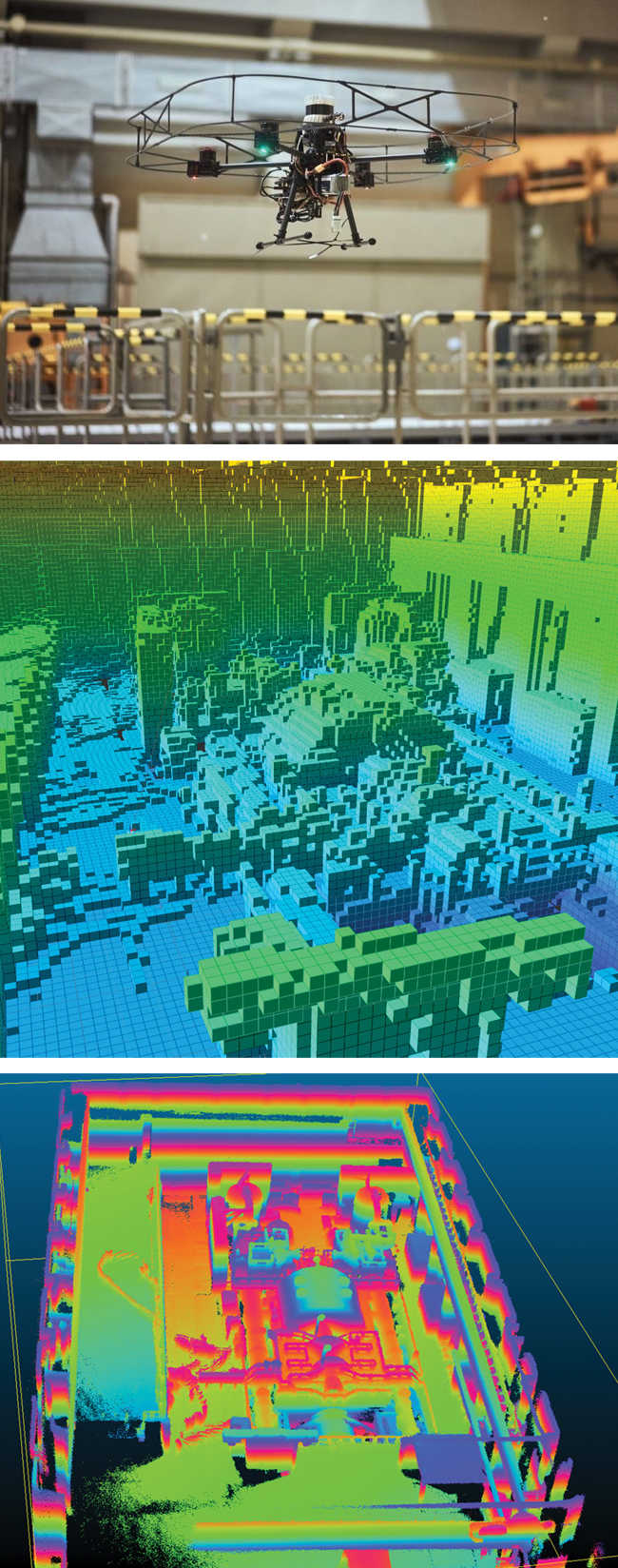
SwRI engineers used LIDAR point cloud data to reconstruct a high-resolution image of a facility that houses electric turbines at a nonoperational nuclear plant. These data visualizations can identify damage and potential hazards following accidents at nuclear power plants and other facilities.
During the European Robotics Hackathon (EnRicH) 2022, SwRI demonstrated an unmanned aerial system (UAS) that autonomously explored and mapped the interior of a nuclear power plant and detected radiation sources autonomously without the aid of a human pilot. The drone technology can potentially assist in life-saving search-and-rescue missions and hazardous inspections at industrial facilities and infrastructure following natural disasters and other incidents.
The event took place in Austria’s Zwentendorf Nuclear Power Plant, the world’s only nuclear facility to be completely built but never activated. The inoperable boiling water reactor plant serves as a training ground to prepare for radiological and nuclear incidents and disaster scenarios.
“Today’s drones and ground robots typically require a lot of input and supervision from a human operator,” said Dr. Eric Thorn, manager of SwRI’s UAS research team. “The autonomy we’ve demonstrated has the potential to significantly reduce the burden on human operators, allowing robotic systems to operate independently.”
Developed and tested through internally funded research, SwRI’s technology combines new algorithms with computer vision sensors to allow drones to autonomously explore and map previously unknown environments.
SwRI’s EnRicH entry featured a quadcopter equipped with several sensors — LIDAR, a time-of-flight camera and radiation detectors. The team utilized both on-drone processors and ground-based processing to perform sensing and perception, simultaneous localization and mapping (SLAM), exploration and other tasks.
“Our exploratory planner, which allows the system to navigate new spaces without the aid of human operators, performed well despite the challenging environment,” said Chris Bang, an SwRI program manager in the Intelligent Systems Division. “The planner is very robust and flexible, adeptly operating in both man-made environments and natural locations such as caves.”
During the EnRicH hackathon, the drone autonomously detected two sources of the radioisotope cobalt-60 hidden in separate locations as part of the challenge.

